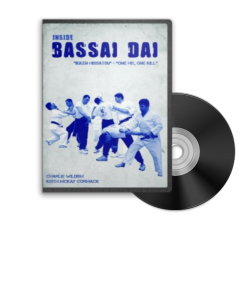In Part 1 of How To Put A “Whip” Into A Linear Punch, I looked at how to use the hips properly to generate a waveform motion through the body for basic punches. Many people struggle with this because as beginners we tend to move the whole torso as one, rather than generating movement from the hips and simply relaxing the rest of the torso so as to let it flow naturally. This puts tension into the body and takes away our power.
The method used in the first video is great for single basic techniques, especially Choku Zuki (straight punch in upright standing stance) and Gyaku Zuki (reverse punch), where we end with the hips square to front or just 10 to 15 degrees past square. Well in this next video we take it a step further. When you snap a towel (or your belt), you have a “pull back” just at the end of the forward movement. We can incorporate this “pull back” to gain extra whip/snap when we perform a snap punch, or multiple techniques (e.g. stepping punch, reverse punch or block then reverse punch). That pull back at the end of the first techniques not only puts an extra whip/snap on the end, but also initiates the hip movement for the second technique.
Now I know that not everybody will have been taught this way, so before you watch my video, please have a quick look at this one by Master Kagawa, 8th Dan Shotokan Karate and Technical Director of the JKS. As he performs Age Uke (rising block) you can clearly see his hips rotate fully, then just settle back slightly at the end of the movement. This settling back (or pull back) gives that extra little “whip” on the end the rising block and can be used to initiate the next technique (which is usually a reverse punch). So for anybody who has not seen this before (and there will be very many who haven’t), I’m not making it up. This is nothing new, it’s always been there, its just always explained in detail. I’ve been lucky with my teachers.
[Waveform punch Part 2]





@Ryan
Thank you. Being a Karateka, I’m honoured to be included in an Aikido journal and newsletter. I think it just goes to show that although our techniques may be different, the underlying principles are the same.
@Jon
Thanks Jon. Sometimes in Shotokan Karate, what I call the “whip” is sometimes called a “vibration”. Especially in our Tekki katas. Ironically, (with the exception of Hangutsu) our Tekki katas are probably the closest katas to Goju Ryu. Goju Ryu is derived from the Okinawan style of Naha Te, which is turn is largely based on White Crane and Praying Mantis Kung Fu and uses a lot of routed stances.
Shotokan however, is derived from Shuri Te, which is less routed and more mobile. I think that is why we struggle more in the Shotokan world to get this whip like movement.
Regards
Charlie
Thank you Sensei. I found this article through an aikido journal daily email newsletter. What a great explanation. I will put this into daily karate practice and be very focused on the wave motion/ hip rotation in my blocks and strikes as you have clearly demonstrated.
Ryan
On this subject, the whipping punch, I have just posted something about how Cain Velsaquez fights so explosively. His whipping punch generates 2230 lbs of force apparently! So it is a good example of the finished product, as it were.
Glad to see you’ve got the finish and reverse action in the equation,like it.
Something that really helped me with this whipping action was training with a guy on a Goju karate course and he started ‘shaking’ so I copied him. We were doing a drill where the techniques were progressively becoming ‘smaller’ and faster as a result. The ‘shaking’ meant that I had no chance of being able to ‘block’ my training partner so I stopped trying as such.
Over the weeks I started messing around with this shaking and was surprised to notice the punches flying out on their own almost. This was when I started to get a realisation of throwing the punch. I sometimes get people to ‘shake like a dog’ in the mirror, it helps get the reverse action going. In effect it is the ‘pull back’ you mention for the single punch.
This really only started me off, it was much later, away from Trad Karate where I learnt how to punch porperly.
I’m enjoying these posts, you’re doing a good job of explaining a difficult topic, you’re not wrong about people struggling with this stuff.
Pingback: Martial Arts News - 1.2.11 | Striking Thoughts